-
current
recommendations- Liefdefjord
New page dedicated to one of Spitsbergen's most beautiful fjords. Background information and many photos.
- New Spitsbergen guidebook
The new edition of my Spitsbergen guidebook is out and available now!
- Liefdefjord
New page dedicated to one of Spitsbergen's most beautiful fjords. Background information and many photos.
Page Structure
-
Spitsbergen-News
- Select Month
- June 2025
- May 2025
- April 2025
- March 2025
- February 2025
- January 2025
- December 2024
- November 2024
- October 2024
- September 2024
- August 2024
- July 2024
- June 2024
- May 2024
- April 2024
- March 2024
- February 2024
- January 2024
- December 2023
- November 2023
- October 2023
- September 2023
- August 2023
- July 2023
- June 2023
- May 2023
- April 2023
- March 2023
- February 2023
- January 2023
- December 2022
- November 2022
- October 2022
- September 2022
- August 2022
- July 2022
- June 2022
- May 2022
- April 2022
- March 2022
- February 2022
- January 2022
- December 2021
- November 2021
- October 2021
- September 2021
- August 2021
- July 2021
- June 2021
- May 2021
- April 2021
- March 2021
- February 2021
- January 2021
- December 2020
- November 2020
- October 2020
- September 2020
- August 2020
- July 2020
- June 2020
- May 2020
- April 2020
- March 2020
- February 2020
- January 2020
- December 2019
- November 2019
- October 2019
- September 2019
- August 2019
- July 2019
- June 2019
- May 2019
- April 2019
- March 2019
- February 2019
- January 2019
- December 2018
- November 2018
- October 2018
- September 2018
- August 2018
- July 2018
- June 2018
- May 2018
- April 2018
- March 2018
- February 2018
- January 2018
- December 2017
- November 2017
- October 2017
- September 2017
- August 2017
- July 2017
- June 2017
- May 2017
- April 2017
- March 2017
- February 2017
- January 2017
- December 2016
- November 2016
- October 2016
- September 2016
- August 2016
- July 2016
- June 2016
- May 2016
- April 2016
- March 2016
- February 2016
- January 2016
- December 2015
- November 2015
- October 2015
- September 2015
- August 2015
- July 2015
- June 2015
- May 2015
- April 2015
- March 2015
- February 2015
- January 2015
- December 2014
- November 2014
- October 2014
- September 2014
- August 2014
- July 2014
- June 2014
- May 2014
- April 2014
- March 2014
- February 2014
- January 2014
- December 2013
- November 2013
- October 2013
- September 2013
- August 2013
- July 2013
- June 2013
- May 2013
- April 2013
- March 2013
- February 2013
- January 2013
- December 2012
- November 2012
- October 2012
- September 2012
- August 2012
- July 2012
- June 2012
- May 2012
- April 2012
- March 2012
- February 2012
- January 2012
- December 2011
- November 2011
- October 2011
- September 2011
- August 2011
- May 2011
- April 2011
- March 2011
- February 2011
- January 2011
- December 2010
- November 2010
- September 2010
- August 2010
- July 2010
- June 2010
- May 2010
- April 2010
- March 2010
- February 2010
- November 2009
- October 2009
- August 2009
- July 2009
- June 2009
- May 2009
- April 2009
- March 2009
- February 2009
- January 2009
- December 2008
- November 2008
- October 2008
- August 2008
- July 2008
- June 2008
- May 2008
- April 2008
- March 2008
- February 2008
- April 2000
- Select Month
-
weather information
-
Newsletter

| Guidebook: Spitsbergen-Svalbard |
Home
→ October, 2022
Monthly Archives: October 2022 − News & Stories
Russia and Norway agree on fishery quotas for the Barents Sea
Western countries have reduced their connections to Russia to a minimum, but there are still a few open channels in use and both sides are still able to make agreements that many will think of as surprising: Norway and Russia have sealed an agreement on fishery quotas for the Barents Sea and the Norwegian Sea, at the Barentsobserver reports.
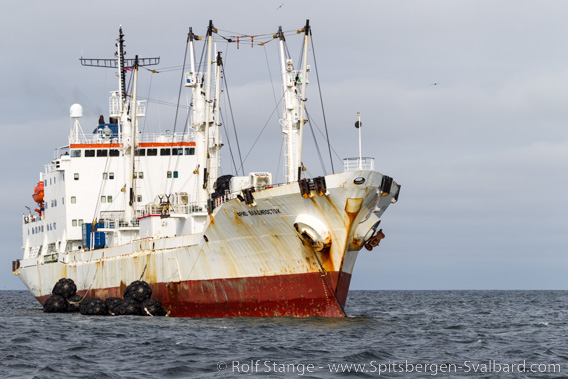
Russian fishing vessel in the Barents Sea.
The Norwegian-Russian Joint Fishery Commission has been in existence since 1976. It sets overall quotas for economically important species such as cod, haddock, capelin and halibut and it defines the share that the fishing fleets of the two countries get. The individual share is usually near 50 % of the total quota.
The quota for cod was reduced now for two times in a row by 20 %.
Norway and Russia also agreed to continue their cooperation within the scientific monitoring of fish stocks and related administration.
As a consequence of Russia’s war against the Ukraine, Norway has closed most ports for Russian fishing vessels. Only Tromso, Båtsfjord and Kirkenes remain accessible for Russian ships, which are regularly subject to minute controls in these ports. Russia has announced to terminate the cooperation with Norway in case the government in Oslo decides on further restrictions. On the other side, Norwegian fishermen complain about frequent closings of large areas in the Russian sector of these waters due to military exercises. This often happens on short notice, which troubles the fishiung fleet.
Russian espionage in Norway including Svalbard
Russia’s hybrid war against the west has started to hit Norway, including the country’s arctic islands of Svalbard. Drones of unknown origin have in recent weeks been seen flying near important infrastructure including technology of the oil and gas industry. In some cases, this has included drones flying several thousand metres high, well beyond the range of small consumer-type drones that are used for example by amateur photographers. Today (Tuesday, 25 October) a man was arrested in Tromsø, as NRK reported. The man is suspected of espionage under false identity for a Russian intelligence service.
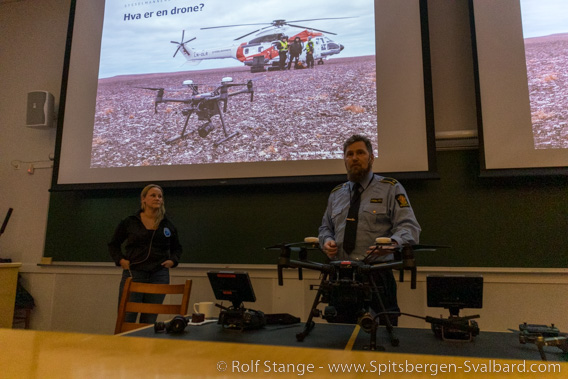
Drones can be used for a wide range of purposes, from innocent photography through scientific work, SAR and police operations up to espionage, military operations and bomb terror. The photo shows a public demonstration of drones used by the Sysselmester of Svalbard for adminstrative purposes and SAR and police operations.
Another man was arrested because of illegal drone flights in Svalbard. According to Barentsobserver, the man has connections to Putin’s environment. He is suspected of having made illegal drone photos that are currently under police investigation. There are several no fly zones in Svalbard, such as the 5 km safety zones surrounding the airports. Additionally, Norway does not allow Russian citizens to fly drones anywhere in Norwegian airspace as a reaction to the Russian war in the Ukraine. A lawyer of the suspected man has indicated to possibly challenge this ban because of the Svalbard Treaty’s requirement of equal treatment, but if such a move would be successful in court is an open question at best.
Such Russian activities are likely intended to create feelings of uncertainty, confusion and fear in other countries.
Mine 7: coal mining until 2025
Norwegian coal mining in mine 7 in Adventdalen near Longyearbyen will be continued until 2025, as the mining company Store Norske Spitsbergen Kulkompani (SNSK) explained in a press release. The reason is the changed geopolitical situation and its implications for global energy markets.
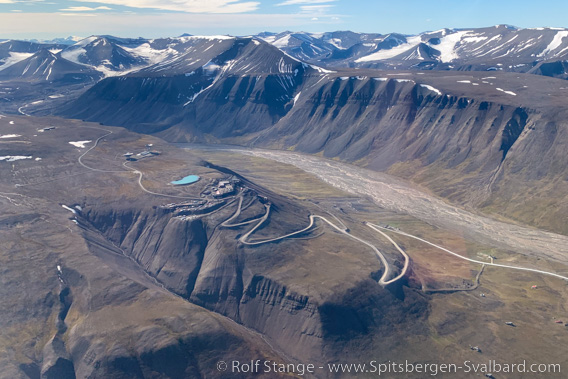
Mine 7 is located on a mountain in Adventdalen.
Earlier, 2023 was set as the last year of Norwegian coal mining in Spitsbergen. One main reason to maintain coal production is, so far, the supply for the local coal power plant, but the community of Longyearbyen aims at finding a new power solution and has not renewed the contract with the mining company beyond 2023.
But the demand for coal on the international markets is high and so are the prices. Hence, SNSK could secure good contracts until 2025. For many years, the Clariant group has been the main customer for Norwegian coal from Spitsbergen, and will remain so until 2025.
In 2021 – before the Russian war against the Ukraine started, SNSK increased its turnover to 93 million Norwegian kroner, compared to 48 million kroner in 2020 – without changes of the annual production.
There are currently between 40 and 45 people working in mine 7. SNSK plans to increase the number of employees in mine 7 to 52, with an annual production of 125,000 tons.
Trust Arcticugol excluded from Svalbard Reiselivsråd
The local tourism association Svalbard Reiselivsråd has excluded Trust Arcticugol from its members. This was decided today (12 October) during a board meeting.
Trust Arcticugol is a company owned by the Russian state. The Trust owns and runs Barentsburg and all activities there, including tourism.

Trust Arcticugol, here in Pyramiden: excluded from Svalbard Reiselivsråd and Visit Svalbard.
One consequence is that the offerings of Goarctica, the Trust’s daughter company for tourims, are not available anymore on Visit Svalbard, an important booking platform for local tour operators.
The reason is the Russian war of aggression in and against the Ukraine. Chairman Ronny Strømnes pointed out that it was not possible anymore to remain passive, considering the Russian invasion and severe violations of public international law and human rights. Strømnes emphasized that today’s decision is directed against the Russian government and not against the people in Barentsburg. He expressed hope that the future development will make normal relationships possible again, including a renewed membership of Trust Arcticugol in Svalbard Reiselivsråd.
Goarctica, the Trust’s tourism branch, published a video on social media showing how the lights are being turned off in various locations in Barentsburg.
Russia, Norway, Svalbard and deep sea cable
One could almost laugh if it wasn’t actually so serious and sad, and with such a dramatic geopolitical background: there is, on one side, a small country that more or less regularly sends a coastguard or navy ship to remote parts of its waters to show presence and to patrol these waters.
And on the other hand, there is a huge country in the neighbourhood, that has been provoking the whole region and many countries beyond that with tools within military and other areas, including internet trolls, cyber attacks and so on and so forth, up to sabotage of public infrastructure.
The big country obviously thinks it has all the right of the world to do all this, or they just pretend it must have been someone else.
At the same time, the same big country claims that the navy presence of the small country is an inacceptable provokation and a breach of important international treaties.
This is, of course, a very much simplified and, to some degree, polemic summary of the current events. But just the fact that it seems safe to assume that all readers will know which countries this is about is tale-telling.
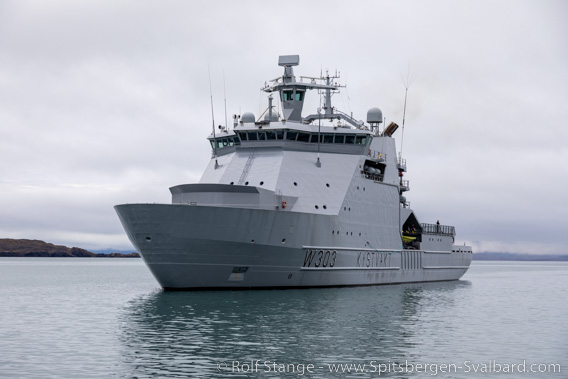
Norwegian coastguard ship in Svalbard waters.
So, what happened now? Recently, Russia accused Norway once again to have breached the Spitsbergen Treaty (often referred to as the Svalbard Treaty) with their military presence in Svalbard. It is the regular presence of Norwegian coastguard ships and occasionaly a frigate in Svalbard waters that allegedly irritates Russia. With this background, it would be an idea to have a look at what the above-mentioned treaty acctually says, but on the other hand, who in Moscow cares about what is actually written in a treaty? But just in case someone elsewhere is interested, this is the relevant Article 9 of the treaty: “… Norway undertakes not to create nor to allow the establishment of any naval base in the territories specified in Article 1 and not to construct any fortification in the said territories, which may never be used for warlike purposes”.
That is actually pretty clear and straightforward. And so are any conclusions one might draw from the text. Norway doesn’t do anything that is in conflict with arcticle 9. Full stop. End of this part of the story. The rest is just provokation.
Another story is that of the deep sea cables. This is, if at all, then only at a very quick, first, superficial glance independent from the first story. There are cables that connect Longyearbyen to mainland Norway, to provide fast and reliable – that is the idea, at least – communication for everything from phonecalls and everyday internet use to satellite data from SvalSat, the satellite antenna field near Longyearbyen which is of great importance for many international users including organisations such as ESA and NASA and others. One of these cables – there are two, for safety reasons – was damaged in January (click here to read more about that). Soon it was established that the damage was done by humans and not by natural processes.
Recently, the movements of a certain Russian fish trawler were debated in media such as NRK. A ship known by the name Melkart-5 crossed the position above the cables in the area of the damage more than 100 times within a few days. Beyond that, there is an impressive list of movements of this ship and its tender near places such as Norwegian oil and gas fields, pipelines and a bridge near Kirkenes that is regularly used during Norwegian military exercises. In addition, there are long periods, where no signal of the ship’s AIS was received anywhere at all.

Russian fishing vessels handing over cargo in Svalbard waters.
These are the facts. Anything beyond this is speculation, considering current public knowledge.
Norwegian authorities including the Sysselmester of Svalbard have expressed regret that legislation to protect sea floor infrastructure dates back to the stone age of these installations and does not provide useful legal tools today.
The Spitsbergen double calender 2023 is available, with Bear Island and Jan Mayen
The brand new Spitsbergen double calender 2023 is available! “Double calendar” means that the 12 calender sheets are used on both sides, and additionally to the twelve beautiful Spitsbergen photos you get another twelve calender pages which are dedicated to Bear Island an Jan Mayen (six sheets for each one of them). As always, my new Spitsbergen double calender has a completely new selection of photographs and it comes in two sizes, A3 (larger) and A5 (smaller). Click here for further information and ordering.
P.S. save money by buying several copies: if you order two or more, then the price per copy is lower. Christmas is on the way, and there is always someone’s birthday coming up 🙂
Frost: queen without land or a criminal polar bear?
As if an animal such as a polar bear could be a criminal. But there are those in Longyearbyen who say that Frost is a criminal polar bear.
According to polar bear scientist Jon Aars, “Frost” is a female polar bear, age almost 17 years, captured and marked by the Norwegian Polar Institute for the first time in 2009 in Wijdefjord and known to scientists as N23992. In later years, Frost got cubs a number of times: twins in 2011, 2012 and 2013 – the rapid series indicated that she must have lost her offspring at least the first two times – and again twins in 2015 and 2017 and a single female cub both in 2020 and 2022. Frost is a well-known polar bear for scientists, who have caught and marked her repeatedly.
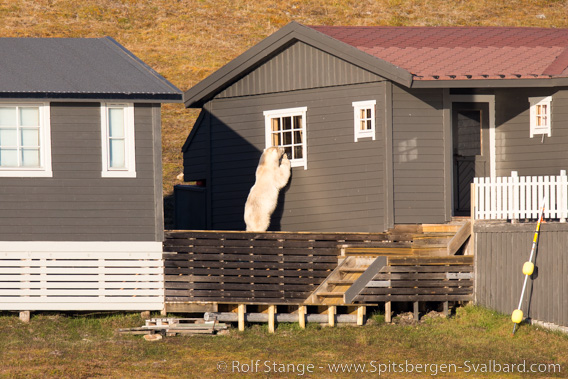
Polar bear and hut in Adventfjord.
It is not known if this polar bear actually is Frost.
Unfortunately, Frost and her siblings have many times had contact to settlements, huts and humans, sometimes with tragic consequences. In 2014, one of her twins from 2013 died in Billefjord under circumstances not fully revealed but in close temporal connection to a scientific anaesthetization. The other one of these two unfortunate twins was shot after it had been in a camp in Tempelfjord in 2015, where one person received minor injuries. The sad climax was, however, reached when one of Frost’s descendants killed camping place manager Johan Jacobus „Job“ Kootte in his tent on the camping place in Longyearbyen on 28 August, 2020. The polar bear was shot.
Frost got her popular name in the documentary “Queen without land” made by the Norwegian film maker Asgeir Helgestad.

Polar bear family in Billefjord, September 2021.
It is unlikely that this is frost, because she got a single cub in 2020.
Frost appears to spend most of her time in Isfjord, with occasional visits to inner Wijdefjord. She has appeared many times in the vicinity of the settlements, Longyearbyen and Pyramiden, and occasionally probably also within them. And she seems to have got used to breaking into huts and trashing them in search for food, as happened recently to the hut of Greendog, a commercial dogyard in Adventdalen near Longyearbyen. The Sysselmester (government representative/police) usually tries to scare polar bears away with flare guns, helicopters of snow mobiles. If this doesn’t work, anaesthetization and a flight to a remote place within Svalbard are amongst the remaining options. But this has already been done with Frost, only to see her coming back a while later. More robust, but non-lethal deterring methods such as rubber bullets or pepper spray or a “polar bear prison” as in Churchill, where bears are kept for a while with only water and no food to teach them that getting too close to settlements and humans is not a good thing, are apparently not in the arsenal of Norwegian authorities.
Which means that a deadly rifle shot soon comes into consideration. This was now proposed for Frost by Longyearbyen’s mayor, Arild Olsen, who said that Frost has become a danger to the public. But such a decision can not be made by Longyearbyen’s mayor. Only the Sysselmester, currently Lars Fause, has the power to decide on this. Fause, however, said that the law does not permit the preventive shooting of a bear. Instead, it allows this final step only in case of danger to human life; in exceptional cases also to protect major material values.
But Fause said he already made up is mind what to do when a polar bear comes close to, for example, the way to school of Longyearbyen’s children.
News-Listing live generated at 2025/June/15 at 07:21:54 Uhr (GMT+1)





























